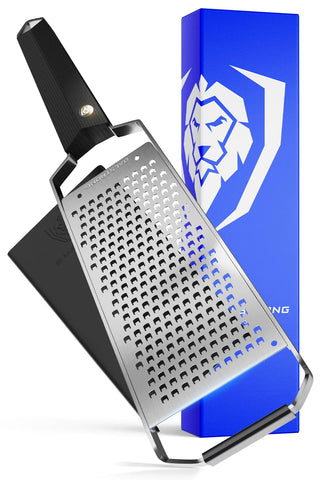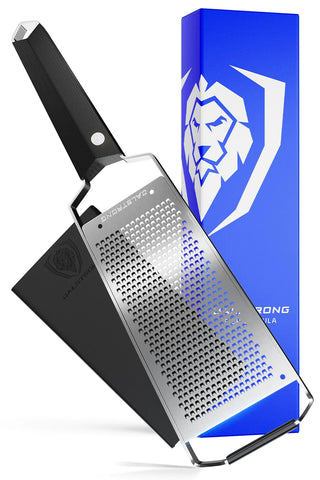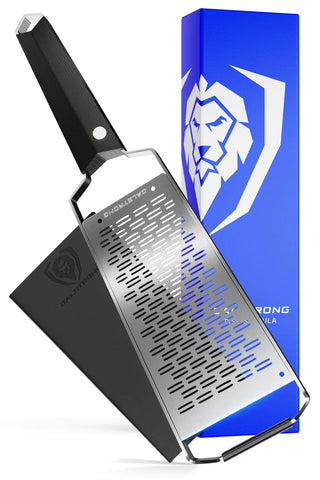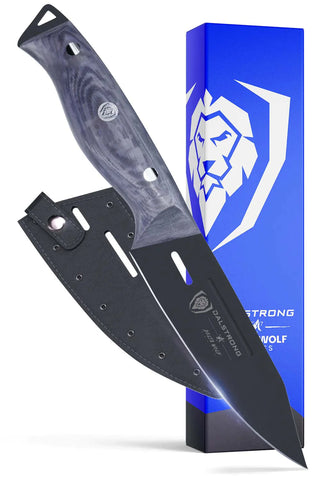 Paring Knife 4" | Scorpion Series | Dalstrong
Paring Knife 4" | Scorpion Series | Dalstrong
Quick Overview: How To Zest A Lemon
- Wash and dry the lemon thoroughly to remove any dirt or wax.
- Select a zesting tool such as a citrus zester or a fine grater.
- Hold the zesting tool firmly and position it over the lemon.
- With gentle pressure, scrape the tool across the surface of the lemon, moving it from top to bottom.
- Rotate the lemon as needed to zest the entire surface, avoiding the bitter white pith underneath.
- Continue zesting until you have collected the desired amount of lemon zest.
- Use the zest immediately in your recipe, or store it in an airtight container in the refrigerator for future use.
- Enjoy the bright and zesty flavor the lemon zest adds to your dishes!
You're in the kitchen, about to bake a delicious lemon cake or maybe whip up a tangy lemon salad dressing. But wait! Before you start, there's a secret ingredient you can't overlook: lemon zest. It's like unlocking a burst of sunshine in your dish, adding that zesty, citrusy flavor that makes your taste buds dance with joy. So, grab your trusty grater and get ready to unleash the magic of lemon zest!
1. What Is A Lemon Zest
 Paring Knife 4" | Quantum 1 Series | Dalstrong
Paring Knife 4" | Quantum 1 Series | Dalstrong
Lemon zest is basically tiny pieces of the outer skin of a lemon. You know how when you rub a lemon against a grater, you get those little shavings? That's lemon zest! It's full of yummy lemon flavor and adds a nice zing to recipes like cakes, cookies, and salads. It's like adding a burst of lemony freshness to your food!
Read about the nine benefits and uses of lemon peel, here.
2. The Five Best Ways To Zest A Lemon
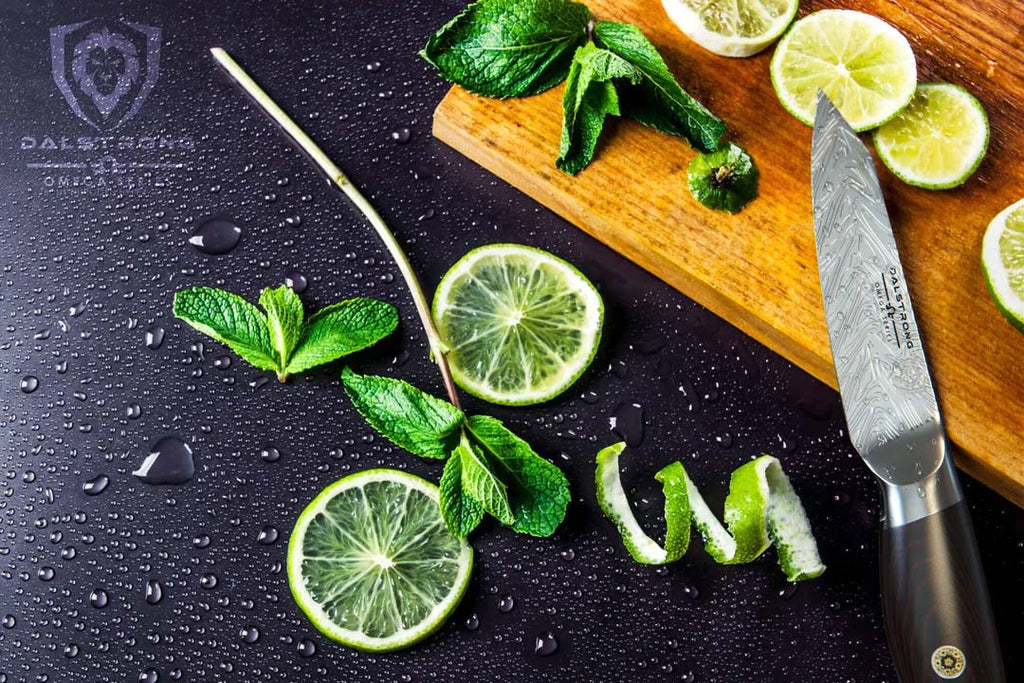 Paring Knife 4" | Omega Series | Dalstrong
Paring Knife 4" | Omega Series | Dalstrong
Here are five easy-peasy ways to zest a lemon:
The Grater Method
Grab a fine grater and gently rub the lemon against it, making sure to only grate the yellow outer skin. Watch those little lemony shavings pile up!
The Zester Tool
If you have a zester tool handy, it's like a mini superhero for zesting lemons. Just run it along the lemon's skin, and voila! Perfect lemon zest strands in no time.
The Peeler Technique
Take a vegetable peeler and carefully peel off just the yellow part of the lemon's skin. Then, chop those peels into tiny pieces for your zest.
The Microplane Grater
This tool is like a ninja for zesting. Hold the lemon firmly and grate it with the microplane, collecting all that fine lemon zest as you go.
The Knife Method
If you're feeling extra skillful, you can use a sharp knife to carefully slice off the lemon's outer skin. Then, mince it up finely for your zest.
3. Easy Recipe With Lemon Zest
 Y Peeler | 3 Blades Case | Dalstrong
Y Peeler | 3 Blades Case | Dalstrong
Here's a super simple recipe for Lemon Zest Cookies:
Ingredients:
- 1 cup of butter (softened)
- 1 cup of sugar
- 1 egg
- 2 cups of all-purpose flour
- 1 teaspoon of baking powder
- Zest of 1 lemon
- A pinch of salt
Instructions:
- Preheat your oven to 350°F (175°C) and line a baking sheet with parchment paper.
- In a large mixing bowl, cream together the softened butter and sugar until it's light and fluffy.
- Beat in the egg until well combined.
- Stir in the lemon zest, ensuring it's evenly distributed throughout the mixture.
- In a separate bowl, sift together the flour, baking powder, and salt.
- Gradually add the dry ingredients to the wet ingredients, mixing until a dough forms.
- Roll the dough into small balls (about 1 inch in diameter) and place them on the prepared baking sheet, spacing them a few inches apart.
- Flatten each ball slightly with the palm of your hand.
- Bake in the preheated oven for 10-12 minutes, or until the edges are lightly golden.
- Remove from the oven and let the cookies cool on the baking sheet for a few minutes before transferring them to a wire rack to cool completely.
And there you have it! Delicious, zesty Lemon Zest Cookies that are sure to brighten up your day with their fresh citrus flavor. Enjoy!
4. Dalstrong Tools For Zesting A Lemon
1. Professional Zester Narrow Grater Dalstrong
This zester grater from Dalstrong is like having a secret weapon in your kitchen arsenal. It's built to make zesting citrus fruits a breeze, giving you that delicious zest to jazz up your dishes.
PROS:
- This grater's blade is razor-sharp, making zesting a breeze. It effortlessly turns the outer peel of lemons, limes, or oranges into fine, flavorful zest.
- It's built tough, with a solid construction that feels durable in your hand. No flimsy parts here!
- The handle is designed with comfort in mind, making it easy to hold and use for extended periods without hand fatigue.
- Not just for zesting! This grater can also handle tasks like grating cheese, ginger, garlic, and more.
CONS:
- Some users may find the grating area a bit narrow, which means it might take a little longer to zest larger fruits or veggies.
2. Professional Coarse Wide Cheese Grater Dalstrong
You know that feeling when you need cheese for your pasta or salad, and you're stuck with a tiny grater that takes forever? Well, say hello to your new best friend – the Professional Coarse Wide Cheese Grater from Dalstrong.
PROS:
- This grater means business with its wide design and solid construction. It can handle big blocks of cheese without breaking a sweat.
- The handle is designed to fit comfortably in your hand, giving you a good grip as you grate away. No slipping and sliding here!
- The coarse grating surface is sharp enough to turn blocks of cheese into fluffy piles in no time. Say goodbye to pre-shredded cheese!
- It's multi-purpose. You can use it to zest lemons, grate veggies, chocolate, nuts, and more. It's like having a multi-tool for your kitchen.
CONS:
- Because of its size, it might take up a bit more space in your kitchen drawer or cabinet compared to smaller graters.
3. Professional Fine Wide Cheese Grater Dalstrong
Imagine a cheese grater that's not just tough, but also delicate like a gentle snowfall of cheese on your favorite dishes. That's what you get with the Professional Fine Wide Cheese Grater from Dalstrong.
PROS:
- This cheese grater has fine blades that work like magic to give you delicate shavings of cheese. Perfect for sprinkling over pasta or salads.
- It's built to last, with a wide design and solid construction. You won't have to worry about it bending or breaking while you're grating.
- Cleanup is a breeze. Just give it a quick rinse under running water, and it's good to go.
CONS:
- Potential Sharpness Hazard:It's important to exercise caution when using and storing the grater.
4. Professional Ribbon Wide Cheese Grater Dalstrong
Adding a touch of culinary elegance to your dishes with beautiful ribbon-like shavings of cheese. That's exactly what you get with the Professional Ribbon Wide Cheese Grater from Dalstrong.
PROS:
- This cheese grater creates beautiful ribbon-like shavings of cheese, perfect for garnishing dishes or adding a touch of elegance to your culinary creations.
- The handle is designed with your comfort in mind, so you can grate away without any hand strain.
- This grater is like having a Swiss Army knife for your kitchen.
CONS:
- Like any sharp kitchen tool, there's a risk of accidental cuts if not handled with care.
5. Paring Knife 4" Delta Wolf Series Dalstrong
Introducing the Paring Knife 4" from Dalstrong's Delta Wolf Series – a little powerhouse in your kitchen arsenal. This pint-sized knife may be small, but don't let its size fool you. It's like a ninja when it comes to precision cutting.
PROS:
- This 4-inch paring knife is like a precision tool in your hand, perfect for intricate tasks like peeling, slicing, and detailed cutting.
- The blade is razor-sharp, making quick work of fruits, vegetables, and other small ingredients. Say goodbye to struggling with dull knives!
- Versatile: It's not just for paring – you can use it for a variety of kitchen tasks, from peeling and zesting lemons, hulling strawberries to deveining shrimp.
- With proper care, this knife will stay sharp and ready to use for years to come. Just give it a quick hand wash and dry after each use.
CONS:
- Some users may find the 4-inch blade to be a bit short for certain tasks that require longer blades.
5. Frequently Asked questions
How do you properly zest a lemon?
To zest a lemon, first, wash and dry it. Then, using a box grater or a citrus zester, gently scrape the outer peel. Be careful to only grate the yellow part, as the white pith is bitter. Use the zest in lemon recipes, desserts, or as a garnish. You can also zest limes and oranges similarly for their unique flavors.
Is lemon zest just peel?
Lemon zest isn't just peel; it's the outer layer of the lemon's skin containing flavorful oils. Use a common kitchen tool like a grater to easily zest. Grate the outer layer in wide strips, avoiding the bitter white pith. Store lemon zest for later use in lemon desserts or as a garnish. Similar methods apply to orange zest and lime zest, utilizing their sharp edges.
Can you use a grater to zest a lemon?
Yes, you can use a grater to zest a lemon easily. Simply wash and dry the lemon, then use the fine side of the grater to gently scrape off the outer layer. Be careful to avoid the white pith, focusing on the top of the lemon. Grate until you have pieces of zest, which can be used for flavoring in various dishes or garnishes.
What is the best tool for zesting lemons?
For zesting lemons, the best tool is a citrus zester. It allows you to easily create thin strips of lemon zest without digging into the bitter white pith. Perfect for home cooks, a citrus zester ensures you get grated zest from fresh lemons, limes, and oranges effortlessly. It's a simple and effective way to zest, and with a few tips, anyone can learn how to zest like a pro.





